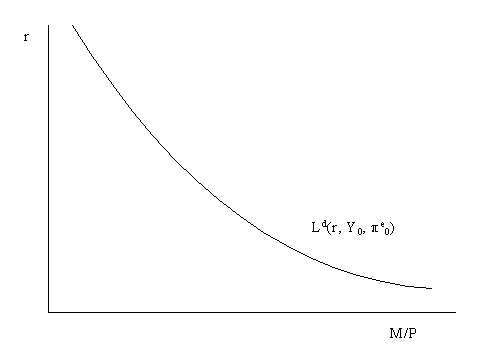
Reading: AB, chapter 7, sections 2 and 3.
The demand for money
Consumption and saving decisions indirectly involve a decision about how much money to hold
Since the general asset allocation problem involves many different kinds of assets with different risk and return characteristics we simplify this decision by assuming that there are only two kinds of financial assets in the economy.
Our model for the demand for nominal money balances takes the following form:

where
Md = demand for nominal money balances (demand for M1)
Ld = demand for liquidity function
P = aggregate price level (CPI or GDP deflator)
Y = real income (real GDP)
I = nominal interest rate on non-money assets
r = real interest rate on non-money assets
e = expected inflation
Since the demand for nominal balances is proportional to the aggregate price level, we can divide both sides of the nominal money demand equation by P. This gives the liquidity demand function or the demand for real balances function:

The left-hand-side of the above equation is the demand for nominal balances divided by the aggregate price level or the demand for real balances (the real purchasing power of money). The right-hand side is the liquidity demand function. The demand for real balances is decomposed into a transactions demand for money (captured by Y) and a portfolio demand for money (captured by i).
The real money demand function is graphed below:

The demand for real balances is graphed as a function of the real interest rate holding income and
expected inflation fixed. When the real interest rate is high the opportunity cost of holding money
- keeping income and expected inflation fixed - is high so that real money demand is low.
Conversely, when the real interest rate is low the opportunity cost of holding money is low so that
money demand is high (due to the liquidity convenience of money over bonds). Whenever income
or expected inflation change the real money demand curves shifts. For example, if Y increases the
real money demand function shifts up and right; if expected inflation increases the real money
demand function shifts down and left.
[Next Slide] [Previous Slide] [Contents for Lecture 7] [Slides from Lectures] [301 Homepage]
Last updated on July 15, 1996 by Eric Zivot.